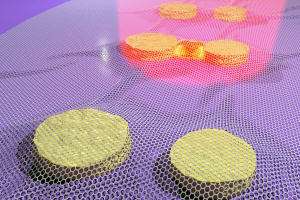'Tense' graphene joins forces with gold nano-antennas

(Phys.org)—Graphene can be used to investigate how light interacts with nano-antennas, potentially increasing the efficiency of solar cells and photo detectors, University of Manchester researchers have found.
Writing in Nano Letters and Physica Status Solidi Rapid Research Letters, a team led by Dr Aravind Vijayaraghavan in collaboration with Professor Stephanie Reich at Freie Universität Berlin and Professor Stefan Maier at Imperial College London, have shown that graphene can be used to investigate how light interacts with gold nanostructures of different shape, size and geometry.
This interaction, through plasmon resonance, is the same phenomenon that gives colour to the gothic stained glass rose window of Notre-Dame de Paris.
When light shines on a metal particle smaller than the wavelength of the light, the electrons in the particle start to move back and forth along with the light wave. This causes an increase in the electric field at the surface of the particle.
When two such particles are brought close to each other, the oscillating electrons in the two particles interact with each other, forming an even higher electric field between the two particles, resulting in a coupling between the two particles. It has proven to be difficult to experimentally observe and measure the magnitude of this coupling and resulting electric field.
Dr Vijayaraghavan's team and collaborators have shown that graphene can be placed on top of such coupled gold antennas of different shapes, and by performing Raman spectroscopy on the graphene, this coupled plasmonic system can be observed and measured.
He said: "When a sheet of graphene, just one atom thick, is placed on top of two gold particles next to each other, the graphene bends around the particles and gets stretched in the gap between the particles. When light falls on the graphene, it is scattered to different extents from the strained and unstrained parts of the graphene.
"Fortunately, the strained part of the graphene also lies in the same region as the plasmonic electric field – in the cavity in between the two dots. This allows us to compare the amount of light scattered by the plasmonic cavity and the surrounding region, and derive a quantity for the enhancement from the plasmonic antenna cavity.
"The light scattered from the strained graphene can be 1000 times brighter than the light from the surrounding graphene."
More information: Heeg, S. et al. Strained graphene as a local probe for plasmon-enhanced Raman scattering by gold nanostructures, Physica Status Solidi RRL, 3rd October 2013. DOI: 10.1002/pssr.201308145
Heeg, S. et al. Polarized plasmonic enhancement by Au nano structures probed through Raman scattering of suspended graphene, Nano Letters, 7th December 2012. DOI: 10.1021/nl3041542
Journal information: Nano Letters
Provided by University of Manchester

















